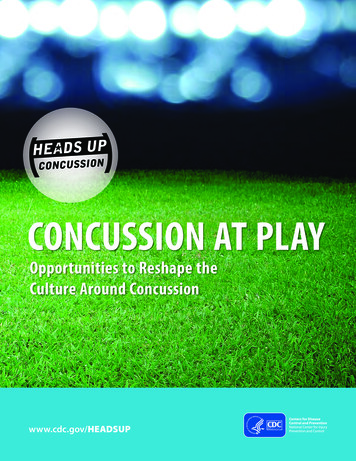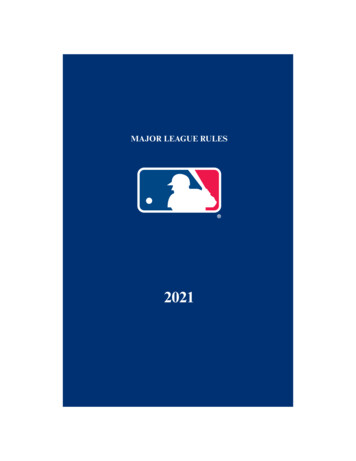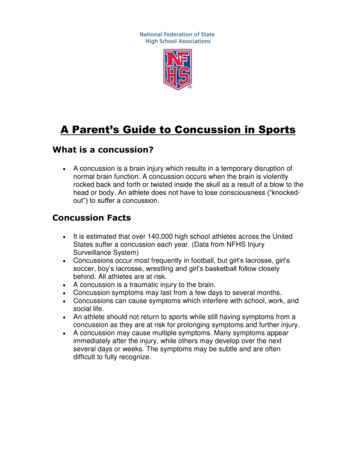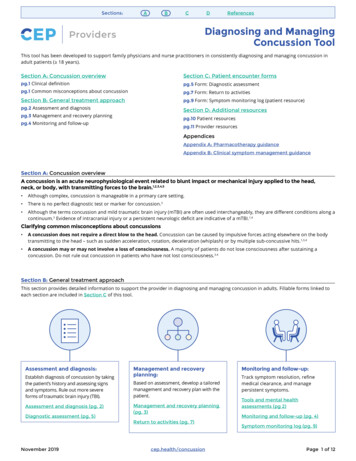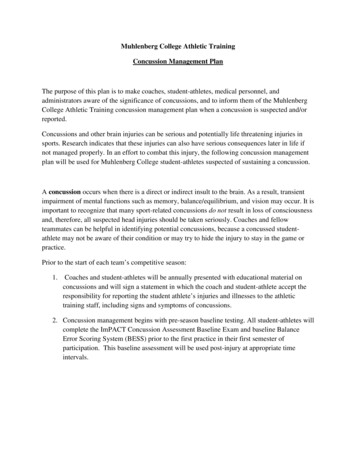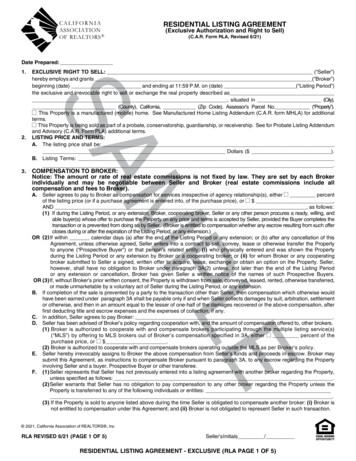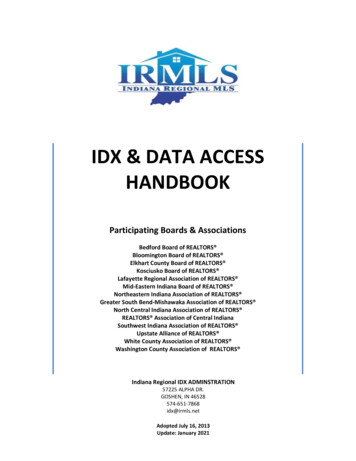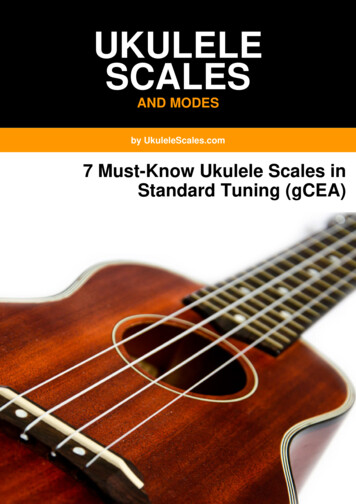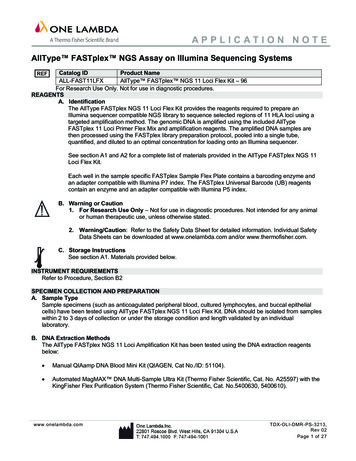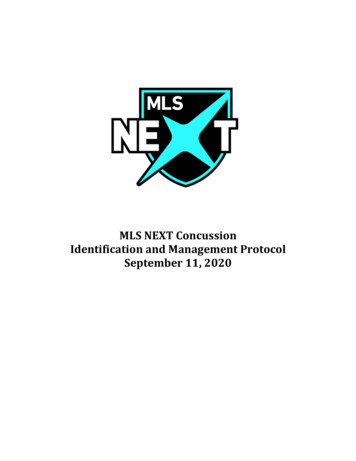
Transcription
MLS NEXT ConcussionIdentification and Management ProtocolSeptember 11, 2020
Table of ContentsPurpose . 1How to Use This Document . 1Education . 1Required Qualified Medical Provider at Games . 2Concussion Basics . 2Signs & Symptoms of Concussion . 3What to Do if You Suspect a Concussion Has Occurred . 4Medical Management . 5Baseline Testing . 8Header Reminder . 8
MLS NextConcussion Identification and Management ProtocolPurposeThe identification and treatment of head injury, including concussion, in the sport of soccer isan important component of MLS Next’s Safety and Wellbeing Policy (the “Safety/WellbeingPolicy”) and is fully incorporated in the Safety/Wellbeing Policy by reference. The MLS NextConcussion Protocol (the “MLS Next Protocol”) sets forth MLS Next’s Rules and Regulationswith regard to the education, diagnosis, recognition, evaluation, and management of theseinjuries. The goal of this MLS Next Protocol is to establish a standardized program that: follows the U.S. Soccer Protocol (defined below), and indirectly, the internationalconsensus guidelines; sets a gold standard in youth soccer; and is actionable by all clubs sanctioned by MLS Next to participate in its CoveredPrograms1 (the “Member Clubs”).Please note that all MLS Next protocols are subject to any more stringent minimum standardsissued in federal, state, provincial and local laws.How to Use This DocumentMLS Next has adopted the U.S. Soccer Federation’s “Recognize to Recover” program, includingits Assessment & Management of Concussion in Soccer (the “U.S. Soccer Protocol”). The latestversion of the U.S. Soccer Protocol is hereby incorporated into this MLS Next ConcussionProtocol (the “MLS Protocol”), except to the extent of any conflicting or more specific terms orclarifications herein. In the event of any conflict between this MLS Next Protocol and U.S. SoccerProtocol, the MLS Next Protocol shall supersede.EducationEducation plays a critical role in concussion identification and management. Prior to thecommencement of each season, all players registered in an Covered Program (“Players”), alltechnical staff, and all medical contractors or staff are required to complete the Centers forDisease Control and Prevention’s “Heads Up to Youth Sports” online training program(available at ndex.html) and submit proofof completion in accordance with MLS Next registration instructions Additionally, such partiesshould review the “USSF Fact Sheet” for their respective groups (Players, coaches, or parents)located at the USSF site ain#concussions).Each Member Club shall implement a procedure to ensure that Players, parents, and Coachesare aware of such documents and encouraged to read them, such as posting the applicableversion in locker rooms, technical staff offices, or emailing the link or a copy to parents, Players,and technical staff, as appropriate.1 This document is incorporated by reference in the MLS Next Safety and Wellbeing Policy and the MLS Next Rulesand Regulations. Any defined term (indicated by capitalization not normally required by grammar rules) that is notdefined in this document shall have the meaning given in those documents.1
Member Clubs shall ensure that their technical and medical staff and contractors havereviewed this MLS Next Protocol, and the USSF Protocol, located at the following site (or areplacement 2049716151/20200218 R2R Concussion Management v3.pdfRequired Qualified Medical Provider at GamesAt each Game (as defined in the Rules and Regulations), the home Member Club shall arrangefor and engage a qualified medical professional (which can include a Certified Athletic Trainer)who is licensed or certified and authorized by state or provincial law to evaluate, manage, andprovide return to play clearance for athletes suspected of, or diagnosed with, concussion(“Qualified Medical Professional” or “QMP”. Additionally, the QMP must have knowledge of theMLS Next Protocol and be familiar with the execution of all medically-related components ofthe Protocol. If the home Club fails to ensure the presence of such QMP, the Game shall becancelled, or if agreed by the away Member Club and referee and not causing delay tosubsequent matches at the field, delayed not more than 60 minutes to allow for arrival orreplacement of the QMP with another QMP. If both Member Clubs and the referee do not agreeto a delay, the home member Club shall be fined and potentially subject to other discipline, inaccordance with this Disciplinary Code, and subject to any exceptions therein. An exceptionmay be based on factors beyond the control of the home Member Club, such as suddenunavailability of the QMP through no fault of the Club (e.g., illness or travel obstacles withoutreasonable advanced notice).It is also recommended, but not required, that a QMP be present at all training sessions,practices and scrimmages.Concussion BasicsMLS Next’s Protocol, like Recognize to Recover, incorporates the definition of “concussion” setforth by the CISG (McCrory et al., 2017). The following is a summary is intended as a referencetool: Concussions are brain injuries.Concussions produce complex physiological processes that occur when traumaticbiomechanical forces are applied to the brain.Concussions may be caused either by a direct blow to the head, face, neck, or elsewhere onthe body, which causes an "impulsive" force to be transmitted to the head. Direct head-tohead contact, typically occurring when two athletes attempt to head the same ball, is themost common injury mechanism, although contact with any object or person on or aroundthe field can result in injury.Loss of consciousness MAY occur but is NOT necessary for concussion.Concussion results in a diverse set of clinical signs and symptoms.The symptoms of concussion may or may not appear immediately; it may take 1 to 2 daysfor the symptoms to become apparent.Concussions typically are not visible on traditional neuroimaging (CT scans, MRI).Neuropsychological or “neurocognitive” tests may be used to detect abnormalities inthinking abilities caused by concussion. However, these tests are only one part of the returnto play decision process and ideally should be interpreted in consultation with aneuropsychologist2
Signs & Symptoms of ConcussionIdentifying a Concussion. Identifying athletes with concussion or suspected of having aconcussion is one of the greatest challenges faced by medical providers. Once considered ahallmark of the injury, loss of consciousness occurs in only 5% or fewer of injuries. Otherclinical signs and symptoms associated with concussion may not develop for minutes, hours, or1 to 2 days after injury. In addition, clinical signs may be difficult to identify and symptoms maynot be disclosed by an athlete who desires to continue to play or is unaware they haveconcussion symptoms. As such, medical providers must be vigilant in their observation ofathletes under their care, both on and off the field.Clinical research has determined that the following signs indicate a high likelihood of adiagnosis of concussion following a direct or indirect blow to the head.1. Lying Motionless / Loss of Consciousness: lying motionless on the playing surface. ThePlayer does not appear to move or react purposefully, respond or reply appropriately to thegame situation (including teammates, opponents, referees or medical staff).2. Unsteady Gait / Motor Incoordination: the Player appears unsteady on his feet (includinglosing balance, staggering/stumbling, struggling to get up, falling) or in the upper limbs(including fumbling). May occur in rising from the playing surface or while walking/running.3. Impact Seizure: involuntary clonic movements that comprise periods of asymmetric andirregular rhythmic jerking of axial (i.e., head, neck, face, jaw or back) or limb muscles4. Involuntary Limb Stiffness / Tonic Posturing: involuntary sustained contraction of one ormore limbs (typically upper limbs), so that the limb is held stiff despite the influence of gravityor the position of the Player. The tonic posturing could involve other muscles such as the axialor lower limb muscles. Tonic posturing may be observed while the athlete is on the playingsurface or in the motion of falling, where the Player may also demonstrate no protective action.5. No Protective Action / Floppy Fall: falls to the playing surface in an unprotected manner(i.e. without stretching out hands or arms to lessen or minimize the fall) after direct or indirectcontact to the head. The player demonstrates loss of motor tone appears limp (which may beobserved in the limbs and/or neck) before landing on the playing surface.6. Blank / Vacant Look: the Player exhibits no or blunted facial expression or apparentemotion in response to the environment (may include a lack of focus/attention of vision). Blank,vacant or confused look is best appreciated in reference to the athlete’s normal or expectedfacial expression.If the Player exhibits any of the six signs enumerated above, or a concussion is suspected forother reasons, the Player shall be first evaluated on the field. If after the on-field assessment,the Player has any concussion-related signs and symptoms, or a diagnosis of concussion cannotbe ruled out, the Player shall then undergo an off-field evaluation (see below). In such case,Player shall be removed from the game and precluded from playing in training or any othergames (whether or not a Covered Program) until cleared to return to play pursuant to this MLSNext policy. If the Player is diagnosed with a concussion by the QMP or the suspicion ofconcussion persists after the evaluation, under no circumstances shall that Player return to playin the same day.Additional Concussion Signs/SymptomsCognitive Signs/Symptoms: (A Player may report this, or it may be observed.) unaware of3
game specifics (opposition colors, score of game, last play); confusion; amnesia (does not recallevents prior to the hit or after the hit); changes in consciousness; not oriented to time, place, ordate; difficulty concentrating, feeling “in a fog.”Physical: headache, dizziness, nausea, unsteadiness/loss of balance, feeling “dinged” orstunned or “dazed,” seeing stars or flashing lights, sensitive to light, pressure in head, fatigue orlow energy, ringing in the ears, and double vision. Difficulties with sleep may develop later –e.g., trouble falling or staying asleep. Sleeping too much.Emotional: depressed mood, sadness, anxiety, irritable, easily frustrated, and heightenedemotionality.What to Do if You Suspect a Concussion Has OccurredConcussive injuries often do not manifest overt signs, making it difficult for even the mostdiligent medical provider to identify all concussed athletes. Athletes, teammates, coaches, andofficials, therefore, have an obligation to report a suspicion of concussion to medical personnelwho will then evaluate the Player pursuant to this protocol. If in a training situation thosewithout medical credentials suspect an athlete may be concussed, they should follow CRT5recommendations (see below), acting conservatively. They should remove the athlete fromparticipation (i.e., practice, conditioning, etc.) and not allow the Player to return until a QMPhas performed an evaluation and cleared the athlete to return. �brain#concussions ).In the event of a suspected concussion: Remove athlete from play immediatelyPlayer should be evaluated by a QMPIf there is no QMP present and symptoms persis, Player should be transported to amedical facility for evaluation. If symptoms resolve, Player should be instructed tofollow up with a QMP prior to return to sport. If a minor, instructions should beprovided to the parent/guardian.Remove from play. Those without medical credentials who observe an impact or the abovereferenced signs and are unsure whether a concussion is suspected should utilize theConcussion Recognition Tool 5 (“CRT5”) provided by the league, not to diagnose the condition,but rather to determine whether a concussion is reasonably suspected. As always, such personshould err of caution and take a conservative approach to whether a concussion is suspected.Evaluation and Diagnosis. All Players suspected of having a concussion should be evaluatedby a QMP. This individual must be specifically trained in the evaluation and management ofsports concussion. Having obtained a medical or other healthcare degree does not, by itself,indicate that the professional is adequately trained for the evaluation of concussion. The Playershould not return to play until a QMP provider has provided clearance for return to play.Understanding that concussion symptoms or signs may not always be present within the firstfew hours of an inciting impact, any Player who is evaluated during a game with an “on-field”assessment that is not initially diagnosed with a concussion shall be evaluated again serially,ideally within 24-36 hours of the initial suspicion of injury by a QMP.4
Players who are suspected of having sustained a concussion during a Game must be evaluatedimmediately on the field of play by the QMP. The evaluation must include at minimum thecomponents of the “On-Field” assessment of the SCAT5 or Child SCAT5 (if the Player is 12 oryounger), including the “ABCs” (Airway, Breathing, Circulation), Maddocks Questions, GlasgowComa Scale, Cervical Spine Assessment and MLS On-field Symptom list.If after this on-field assessment, the QMP determines that a suspicion of concussion persists, amore complete off-field evaluation is needed, including the full SCAT5 or Child SCAT5. Such anevaluation must be performed off-field and (to the extent reasonably possible) in a distractionfree environment. Players who are evaluated by the QMP and not diagnosed with a concussionand for whom there is no continuing suspicion of concussion may return to play in the samegame. For a Player to return to competition following such evaluation, the QMP must clear thePlayer to return. Such QMP shall complete an incident report that details the evaluation andthe reasoning for allowing a return to the Game. This can be completed after the Game. Thisclearance shall not circumvent the prohibition on same-day return to play.SCAT5. MLS Next requires that the QMP be trained and facile in utilization of the SCAT5 andChild SCAT5 concussion evaluation tools. For all Players under the age of 13, the Child SCAT5should be used. Off-field evaluation must consist of the full SCAT5 (or Child SCAT5) test,regardless of the time it takes to conduct. A copy of each tool can be found brain#concussions stitutions Related to Head Injury and Evaluation. The USSF’s Head-Injury SubstitutionRules shall be incorporated into this MLS Next Protocol, unless otherwise indicated in anamendment to this MLS Next Protocol. These Rules shall apply to MLS Next in the same manneras they reference the “Development Academy.” See Addendum A, attached.Neuropsychological Testing. The use of neuropsychological or “neurocognitive” tests hasbecome widespread in the evaluation and management of concussion. These tests measure“thinking” abilities such as learning, memory, problem solving, information processing speedand reaction time, which are often - but not always - affected by concussion. All Players in theMLS Next youth development league shall have baseline testing (ImPACT) completed at thestart of the season. The test is then repeated after a concussion and the results are compared tothe baseline test. The tests have shown to be useful in assessing the effects of concussion evenif a baseline test is not available. A neuropsych ologist is in the best position to interpret theresults of these tests.In order for a QMP to access the Player’s baseline test, the Player should provide the ImPACT“Passport ID“ code given to the Player upon completion of the last baseline test taken. A Playerwho cannot find such Passport ID should contact MLS Next m.Medical ManagementFollowing a concussion diagnosis, an athlete should be removed from further sportparticipation with instructions to engage in relative physical and cognitive rest. Returning toplay on the same day as a suspected concussion without appropriate medical clearance is nowuniversally prohibited for all athletes by U.S. Soccer (and by MLS Next) and by many state or5
and provincial laws in youth cohorts. Relative rest, typically lasting on the order of 24-48 hours,is defined as limiting the athlete to activities that do not exacerbate concussion-relatedsymptoms or provoke new symptoms. While this means removing the athlete from sportparticipation to reduce injury exacerbation, the medical provider may also considertemporarily modifying or limiting school (including physical education) and other activities ifthey provoke symptoms. Extended periods of “complete rest” (more than 5 days) and inactivityare not recommended and may be harmful.As the Player’s symptoms improve day-to-day activities may be gradually increased under theguidance of a QMP as long as the introduction of activities (e.g., walking, reading, computeruse) does not elicit new concussion-related symptoms or cause significant exacerbation ofexisting concussion-related symptoms (e.g., introducing walking, reading, computer use).Progression through the graded RTP process shall be under the direction of the Player’s QMP.At all times, the Player shall be monitored for a re-emergence or exacerbation of concussionrelated symptoms, which would lead to a pause in the progression and subsequent resumptionof activity as tolerated. The Player’s QMP is responsible for reviewing the Player’s progress,and any challenges that emerge. The Player’s parent or legal guardian (including parent) isresponsible for communicating that progress with the Member Club technical staff, and theMember Club shall inform the parent or legal guardian of this responsibility and the preferredmanner of communication.Prior to return to contact play, the Player must be evaluated by a QMP who must providewritten clearance for return to play, including exercise and training. No technical staff shallallow the Player to engage in full contact activity until a written clearance to do so by a QMP hasbeen received.Graded Exercise Progression. A graded return to play progression must be supervised by aQMP. An example of a return to play progression is provided below. Other information isavailable 9716151/20200218 R2R Concussion Management v3.pdf).1. Light aerobic exercise (e.g. stationary bicycle) for 15-20 minutes (do not allow Playerto break a sweat)2. Moderate intensity aerobic exercise (30 minutes, moderate intensity, breaking asweat)3. Sport-specific training (ball handling, passing, light running, NO heading)4. Non-contact training drills, including full exertion interval training (may start lightresistance training)5. Full contact training with heading6. Return to competition (game play)Typically, a Player progresses from one step to the next every 24 hours as long as concussionrelated symptoms do not newly emerge, reemerge, or become exacerbated. If the Playerdevelops symptoms during one of the steps the activity should be stopped and the Player shouldbe allowed to rest for 24 hours or until such symptoms resolve, whichever is later. The Playershould then return to the prior step and resume the progression. The QMP shall be whollyresponsible for determing the level of permissible activity, and whether a Player can engage in6
such with or only without certain symptoms.Patience is key as symptoms may re-emerge during this process. Do not attempt to speed upthis process unless under the supervision of a well-qualified concussion specialist who hasaccess to a multi-disciplinary team of qualified healthcare professionals.Return to Play. Return to full contact play shall only occur once the Player is free of concussionrelated symptoms and permitted in writing by the Player’s QMP and only occurs after (1) playeris free of concussion-related symptoms at rest, (2) Player remains free of concussion-relatedsymptoms after a graded exercise progression, and (3) the Player is judged by the QMP to beat his or her neurocognitive baseline. At this point the appropriately trained healthcareprofessional should provide a written note clearing the Player for full-contact play.Baseline TestingImPACT Baselines. ImPACT is a computerized neurocognitive assessment program. Initially,each team must conduct baseline tests for all athletes, and confirmation of completion must bereceived before the start of the first unrestricted contact play of the season. Baseline tests mustbe repeated every other year and, if the Player previously had only the ImPACT Pediatric test,once a Player turns 12. The Baseline test results should not be interpreted by testadministrators, except for identifying invalid baselines designated as “Baseline ” by theImPACT program, in which case the test must be repeated. Otherwise, interpretation of baselineand post-injury ImPACT data is only to be performed by medical professionals who are trainedin the interpretation of ImPACT data, when tasked with post-injury return-to-play decisionmaking. The test may be conducted by non-technical club staff, including administrators,athletic trainers, or medical professionals. No coaches are to administer the ImPACT test. Thetest administrator must have completed ImPACT training as specified below, which is availableat no cost online. ImPACT will e-mail each Club Administrator the required login credentialsin a separate communication.For children under 12 years of age, Players must be tested using ImPACT Pediatric, and the testmust be administered in person, on an iPad, and only in a one-on-one setting, but never at home.The required training for ImPACT Pediatric is available e/.For children 12 years of age or older, the test must be administered in person at a teamdesignated site (never at home), on a personal computer or laptop with an external mouse, andin small groups with no more than 5 Players. You will be directed to this link datwww.impacttestonline.com/customercenter. Instructions for (non-pediatric) Baseline testingadministration are included in the MLS Next ImPACT Baseline Testing Instructions, which canbe found at https://www.mlssoccer.com/mlsnext/resources. ImPACT’s Administration Manualis also attached for test administrators. The required training is available ‐courses/impact‐onboarding‐bundle/.You may note that these training bundles include sessions entitled, “Customer Center WalkThrough” and “Impact Basic Report Interpretation.” Those sessions only apply to QMPs.7
SCAT5 Baselines. MLS Next reserves the right to implement baseline SCAT5 testing, subjectto reasonable advance notice. Such program will be incorporated by reference into thisdocument, and all Member Clubs shall be subject to its requirements.Please note that all required testing should be administered pursuant to the limitations on one‐on‐one interactions, as outlined in the MLS Safety and Wellbeing Policy.Heading ReminderTechnical staff and Players are reminded that the rules of U.S. Soccer and MLS Next prohibitheading the ball by Players 11 years old and younger, regardless of the age group in which theyplay.8
ADDENDUM AU.S. Soccer Development Academy Head Injury Substitution Rule:If a player in a Development Academy game suffers a blow to the head, is suspected of havingsuffered a concussion or has an apparent head injury during the course of a game, the clubmust remove the player from the game for a medical evaluation by a healthcare professional(HCP) or an athletic trainer certified (ATC) with a skill set in emergency care and sports medicineinjuries and with knowledge and experience related to concussion evaluation and management.Effective January 1, 2016, the home team for all regular season Development Academy games(which excludes showcase events, playoffs and championships) will be responsible for providingan HCP or an ATC at each game, regardless of where the game is being played. This medicalprofessional will have the final authority on head injuries, and must be made available to thevisiting team if they did not travel with an HCP or ATC.The Development Academy substitution protocol has been amended to allow a temporarysubstitute to replace the injured player while the player is being evaluated. This amendment isonly applicable for head injuries; all other injuries will follow the standard Academy substitutionprotocol.A team may only make a temporary substitution if they have at least one substitutionand one substitution moment remaining. In the event there are multiple playersbeing evaluated with head injuries from the same team at the same time, that teamcannot make more temporary substitutions than the number of substitutions andsubstitution moments that team has remaining. For example, if two players from thesame team receive head injuries at the same time, that team needs two availablesubstitutions, but only one available moment because the injury to both playersoccurred at the same time (injured players that are cleared can re-enter at separatestoppages.)The temporary substitution will not count against the team’s total number of allowedsubstitutions or substitution moments. If the player being evaluated has received clearancefrom the HCP or an ATC to return to the game, that player may re-enter at any stoppage of playand must replace the original temporary substitute, who will remain an available substitute andwill be permitted to re-enter the game. Any cautions assessed to that player while in the gameas a temporary substitute will carry with the player for the remainder of the game. In the eventthat player receives a red card while in the game as a temporary substitute, the player must exitthe game and the team must play a man down. Following the send-off, if the player beingevaluated for a head injury is cleared to return, the player may re-enter the game but the teamwill have to utilize a substitution and a substitution moment.If the game ends before the evaluated player is cleared to return, the temporary substitute willbe marked on the game report as a standard substitute.If the player being evaluated for a head injury is not cleared to return, the temporary substitutewill remain in the game and the team will be assessed a substitution and substitution moment.
Possible ScenariosIf there is only one substitution and/or moment remaining and a temporarysubstitute enters the game, can the teams make any other substitutions whilethe injured player is being evaluated? NoA temporary substitute receives a head injury while in the game If a temporary substitute receives a head injury while in the game as a temporarysubstitute, that player may be replaced by an additional temporary substitute, but onlyif that team has a second moment and second substitution remaining If there is not a second moment and substitution remaining, the team must play a mandown until either the original player or the temporary substitute being evaluated havebeen cleared to return If a second temporary substitute is utilized and both the original player and the firsttemporary substitute are not cleared to continue, the second temporary sub can remainin the game and that team will only need to use one moment and one substitutionTwo players on the same team receive head injuries at the same time To replace both players with temporary substitutes, the team must have twosubstitutions but only one moment remaining If both players being evaluated are not cleared to return, the team will still only becharged one moment, even if the temporary substitutes become formal substitutes atdifferent timesWhat if the player being evaluated receives a red card? The temporary substitute must come off the field The team plays a man down The temporary
MLS Next Concussion Identification and Management Protocol Purpose The identification and treatment of head injury, including concussion, in the sport of soccer is an important component of MLS Next's Safety and Wellbeing Policy (the "Safety/Wellbeing Policy") and is fully incorporated in the Safety/Wellbeing Policy by reference. The MLS Next
